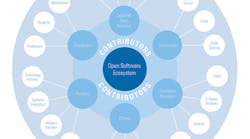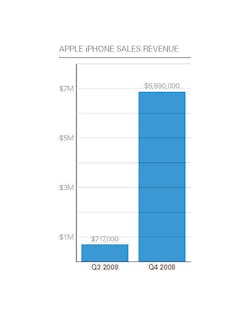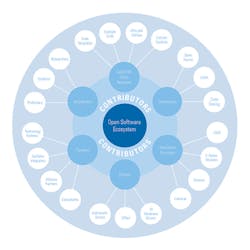This file type includes high-resolution graphics and schematics when applicable.
If Microsoft had never allowed anyone to create applications for Windows, the most ubiquitous operating system on the planet would have never taken off. That, of course, wasn’t the case. Instead, the Windows software-development kit was created alongside the OS from the very beginning. Microsoft’s goal for an OS wasn’t just to build a software product for managing the personal computer. It was to provide an open platform, and Windows became the most widely used platform for personal-computing software in history.
The Promise of Platforms
Products live and die by the investment that their companies can afford to spend developing them, but an open platform has the potential to flourish far beyond its founders. That’s because virtually anyone can build on top of an open platform. This creates a real opportunity for third parties to extend the capabilities of a platform and help grow its adoption by adding value for its users. Even the largest companies cannot meet the demands of every single unique audience they hope to serve. Without an open platform, they will eventually have to turn away those users.
Companies like Microsoft, Apple, and NI have opened their doors and unlocked their APIs to enterprising developers to enable entire ecosystems of contributors and partners to fill those niche needs and build successful businesses around their platforms. The result is catalytic growth in platform adoption, because more users attract more contributors and more contributors attract more users. It’s a win-win situation. Take Apple as an example. Its iPhone sales rose from $717,000 in Q3 2008 to $6,890,000 in Q4 2008 after launching the Apple App Store.
Open Platforms and Ecosystems
Today’s ecosystem of smartphone applications is so prolific that it’s hard to imagine a time when smartphones were closed to third-party developers. However, this open-platform strategy has yet to bleed into markets outside of consumer technology. The test, data-acquisition, and industrial-control spaces have historically seen a small group of dominant players sweep the market with closed, purpose-built systems because these spaces lacked an open-platform approach.
Consider that most of the closed-platform solutions for these industries first came to market in a different era, a time when proprietary software ruled and the notion of a developer community did not exist. Most electronic devices for industry still rely on the old model—closed software that cannot be customized or even extended. This model still works well for companies selling highly specialized devices with a high price tag to serve vertical applications. But that inflexible approach is time-bound because it serves a specific need that exists today and cannot adapt to changes in the application scope.
On the other hand, the open-platform approach is designed to meet continually evolving future needs that cannot be predicted today. Not even Apple could have imagined that a smartphone might be used as a navigation system, fitness tracke,r or even a bagpipe tuner. Thanks to Apple’s open ecosystem, though, partners have built software to enable these unique use cases.
Closed-platform vendors will have trouble keeping up with their customers’ needs because they are limited by their own R&D departments and their own imagination. In a closed ecosystem, users cannot make changes themselves and partners are locked out from creating helpful add-ons. Since no company has unlimited R&D resources, the increasing pace of technology and user demands will inevitably overwhelm closed-platform vendors.
Open-platform vendors have the advantage of boosting their own design team by 10X to 100X—for free—due to all of the third-party developers creating tools and IP to complete their platforms. For NI, this concept goes further because even the users are adding value in the open ecosystem. Unlike many test-and-measurement devices that are shipped with purpose-built software applications, NI hardware can be programmed using open software tools. The open NI platform has organically attracted industry experts who use their domain knowledge to add capabilities to NI platforms as well as create software interfaces to third-party devices through instrument drivers.
Open-Source Benefits and Challenges
One point of debate around open platforms is how open is open enough? From a software point of view, nothing is more open than open source, and one of the most open software platforms today is Linux. The source code for the Linux OS is freely available, and the popularity of Linux has steadily grown thanks to a flourishing ecosystem of contributors who add software features and tools. The only problem with open-source software is that users must take on the burden of building around it before it can be applicable to their use cases.
Consider an embedded control system, one that requires designers expend lots of effort to integrate Linux with their microprocessor architectures, build up the necessary middleware and hardware drivers, and then build out the interaction with the outside world in terms of UX. In this case, the platform is too incomplete for users who want to add value in the core of their applications rather than build up the context necessary to run basic functionality. Here, the right amount of proprietary software can help build up the context of an application and ensure quality while providing enough openness for users and contributors to add core value.
Since Apple’s iOS platforms encompass both OS and hardware that have been built and tested together, they can ensure a reliable experience for their users and provide a stable base for application developers to build on. NI follows this strategy by providing an integrated software and hardware platform for industries where quality and stability are considerably more important, such as aerospace, automotive, medical, energy, and industrial machinery.
For example, NI embedded platforms are based on NI Linux Real-Time, a Linux distribution built using the standard OpenEmbedded framework for ARM and x64 processor architectures. Since NI handles hardware integration through middleware and drivers, embedded developers get a head start on their development while enjoying the freedom and flexibility of an open-source OS.
The Importance of Contributing to Open Platforms
Companies that truly believe in the open ecosystem not only provide open platforms for others to build on, but also build their technologies on top of other open platforms and participate as active contributors to the open-source community. NI has partnered with Google and the Linux Foundation on the new Real-Time Linux (RTL) Collaborative Project.
RTL is a Linux Foundation Collaborative Project that brings together industry leaders and experts to advance and maximize technologies for the robotics, telecom, manufacturing, aviation, and medical industries, among others. Real-time properties make it possible to control robots, data-acquisition systems, manufacturing plants, and other time-sensitive instruments and machines from RTL applications. This project provides the critical infrastructure for some of the world’s most complex computing systems. RTL will save the industry millions of dollars in research and development, and NI has already deployed these real-time capabilities on all of its embedded devices.
Collaboration for Survival
In the new world of collaborative engineering, only the companies who participate in and help create engaged, open ecosystems will survive. In turn, closed platforms will inevitably become obsolete. Open ecosystems grow stronger over time because as their adoption increases, more tools and services pop up around them, which leads to further adoption. Closed ecosystems may never be able to keep up with today’s new business model of selling technology.
The registered trademark Linux is used pursuant to a sublicense from LMI, the exclusive licensee of Linus Torvalds, owner of the mark on a worldwide basis.
Looking for parts? Go to SourceESB.




